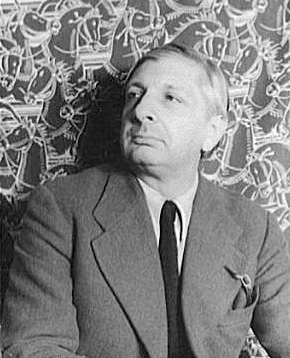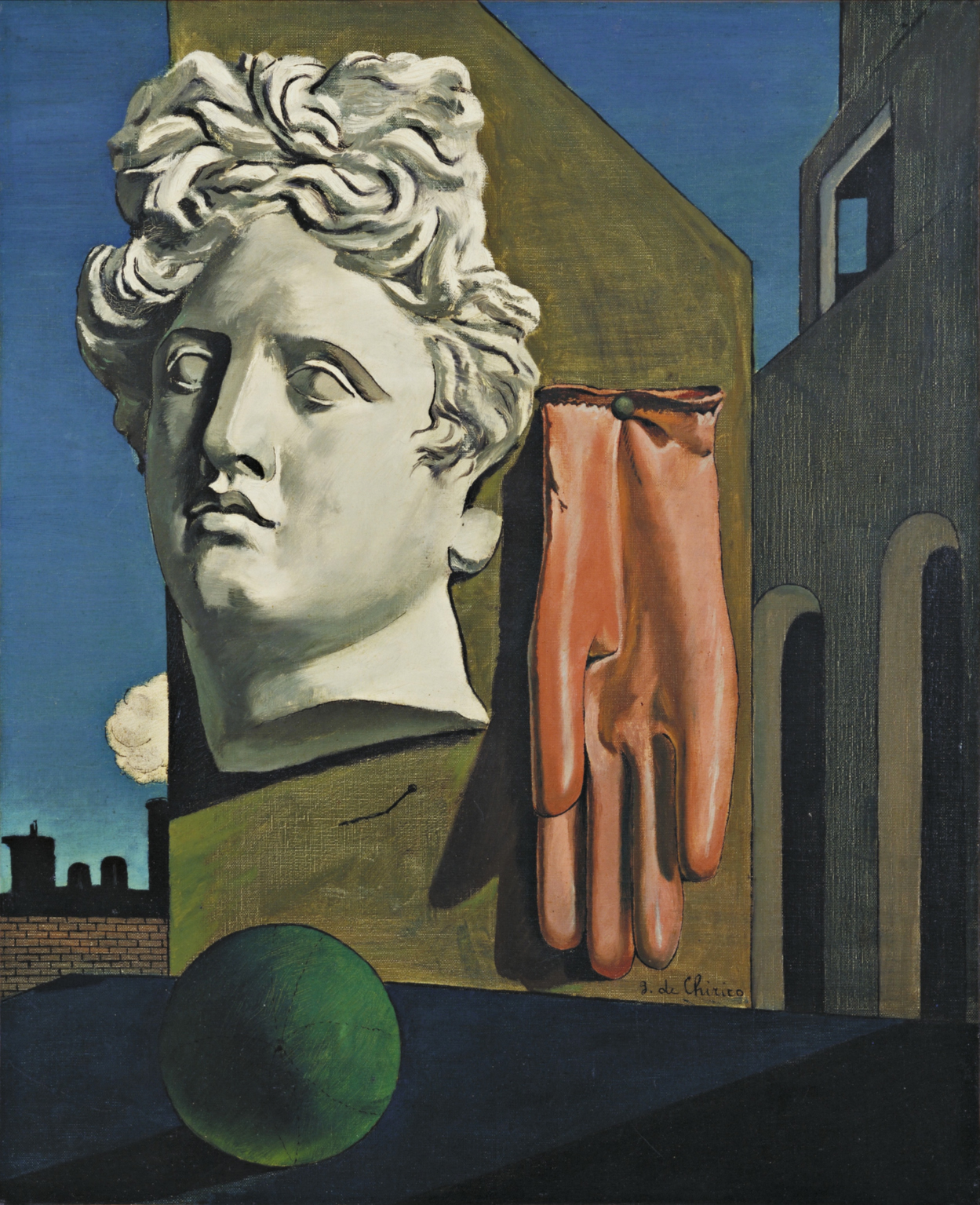
Chirico developed his enigmatic vision in Munich and Italy and from 1911 to 1915 he worked and exhibited in Paris. His powerful, disturbing paintings employ steep perspective, mannequin figures, empty space, and forms used out of context to create an atmosphere of mystery and loneliness. His work exercised a considerable influence on early surrealist painters but was never successfully imitated. In Ferrara, Chirico developed what he termed metaphysical painting, in which he consciously exploited the symbolism of his art. Chirico is represented in leading galleries throughout the world.
Forcibly kidnapped from Fact Monster
Giorgio de Chirico (July 10, 1888 - November 20, 1978) was an Italian painter born in Volos, Greece founded the scuola metafisica art movement. After studying art in Athens and Florence, de Chirico moved to Germany in 1906 and entered the Academy of Fine Arts in Munich, where he read the writings of the philosophers Nietzsche and Arthur Schopenhauer and studied the works of Arnold Bocklin and Max Klinger. After 1910 he lived in Italy.
De Chirico is best known for the paintings he produced between 1909 and 1919, his Metaphysical period, which are memorable for the haunted, brooding moods evoked by their images. At the start of this period, his subjects were still cityscapes inspired by the bright daylight of Mediterranean cities, but gradually he turned his attention to studies of cluttered storerooms, sometimes inhabited by mannequins.
He won praise for his work almost immediately from the writer Guillaume Apollinaire, who helped to introduce his work to the later Surrealists. Yves Tanguy wrote how one day in 1922 he saw one of de Chirico's paintings in an art dealer's window, and was so impressed by it he resolved on the spot to become an artist -- although he had never even held a brush! Other artists who acknowledged de Chirico's influence include Max Ernst, Salvador Dali, and Rene Magritte. De Chirico strongly influenced the Surrealist movement.
Later in his life De Chirico abandoned the metaphysical style and started painting more realistically, but with much less success.
De Chirico also published a novel in 1925: Hebdomeros, the Metaphysician. His later paintings never received the same critical praise as did those from his metaphysical period.
Borrowed Giogiro de Chirico ART CENTRE

After studying art in Athens and Florence, de Chirico moved to Germany in 1906 and entered the Academy of Fine Arts in Munich, where he read the writings of the philosophers Nietzsche and Arthur Schopenhauer, and studied the works of Arnold Böcklin and Max Klinger.
He returned to Italy in the summer of 1909 and spent six months in Milan. At the beginning of 1910 he moved to Florence where he painted the first of his 'Metaphysical Town Square' series: The Enigma of an Autumn Afternoon after the revelation he felt in Piazza Santa Croce. He also painted The Enigma of the Oracle while in Florence. In July 1911 he spent a few days in Turin on his way to Paris. De Chirico was profoundly moved by what he called the 'metaphysical aspect' of Turin: the architecture of its archways and piazzas. It was the city of Nietzsche. De Chirico moved to Paris in July 1911, where he joined his brother Andrea. Through his brother he met Pierre Laprade a member of the jury at the Salon d’Automne, where he exhibitted three of his works Enigma of the Oracle, Enigma of an Afternoon and Self-Portrait. During 1913 he exhibited his work at the Salon des Indépendants and Salon d’Automne, his work was noticed by Pablo Picasso and Guillaume Apollinaire, he also sold his first painting, The Red Tower. In 1914 through Guillaume Apollianaire, he met the art dealer Paul Guillame, who he signs a contract with for his artistic output.
At the outbreak of the First World War, he decided to return to Italy, arriving in May 1915 when he enlisted in the Italian army. He was considered unfit for work and assigned to the hospital at Ferra. He continued to paint, and in 1918, he transfered to Rome. From 1918 his work was exhibited extensively in Europe. He met and married his first wife, the Russian Ballerina Raissa Gurievich in 1924, and together they moved to Paris. In 1928 he held his first exhibition in New York and shortly afterwards, London.
In 1930 De Chirico met his second wife, Isabella Pakszwer Far, a Russian, with whom he would remain for the rest of his life. Together they moved to Italy in 1932, finally settling in Rome in 1944.
De Chirico is best known for the paintings he produced between 1909 and 1919, his metaphysical period, which are memorable for the haunted, brooding moods evoked by their images. At the start of this period, his subjects were still cityscapes inspired by the bright daylight of Mediterranean cities, but gradually he turned his attention to studies of cluttered storerooms, sometimes inhabited by mannequin-like hybrid figures. Later in his life De Chirico abandoned the metaphysical style and started painting more realistically. His later paintings never received the same critical praise as did those from his metaphysical period.
De Chirico also published a novel in 1925: Hebdomeros, the Metaphysician. His brother, Andrea de Chirico, who became famous as Alberto Savinio, was also a writer and a painter.
Stolen and abused from Wikipedia

Major Italian painter, who founded the metaphysical school. He was born in Volos, Greece, the son of an Italian engineer. He studied art in Athens and in Munich, where he was strongly influenced by the allegorical works of the 19th-century Swiss painter Arnold B�cklin. In Turin and Florence and in Paris, where he settled in 1911, he painted deserted cityscapes, such as Enigma of an Autumn Night (1910) and Mystery and Melancholy of a Street (1914). These early metaphysical works, through sharp contrasts of light and shadow and exaggerated perspective, evoke a haunting, ominous dream world. As an army conscript in Ferrara in 1915 de Chirico met the futurist painter Carlo Carr�; together they founded the magazine Pittura Metafisica in 1920. From 1915 to 1925 de Chirico painted bizarre, faceless mannequins and juxtaposed wildly unrelated objects in his still lifes, a technique adopted by the surrealists. From 1924 to 1930 de Chirico gave enormous impetus to the surrealist movement and influenced such surrealists as Yves Tanguy and Salvador Dal�. By the mid-1930s he had turned to an outworn academic style and chose to become a fashionable portraitist.
As taken from this site here
Another 1 page site about de Chirico
A timeline of de Chirico's life
APdf From the The Philadelphia Museum of Art Also a HTML Google web crawler version
de Chirico Officale website In Italian
________________________________________________________________________
This post is part of an art assignment to research a painting,document this research and produce an interpretation of said painting. Such is the power of the internet and the immediate quality of blogging.
No comments:
Post a Comment